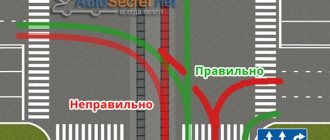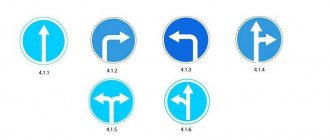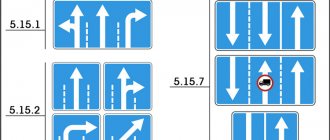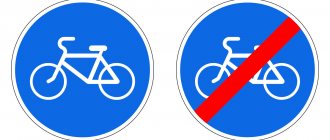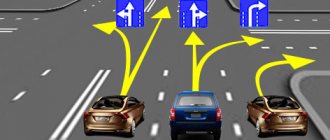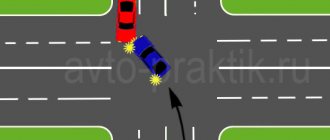Turn right - enter the adjacent territory or yard
Sometimes it happens that another car is parked in front of the entrance. He may be standing in violation of traffic rules or without a violation, it doesn’t matter, but he is standing exactly in front of the entrance where you need to turn.
In general cases, when turning right from the right lane is free, the driver’s sequence of actions is usually as follows: When moving in the far right lane, it is necessary to turn on the right turn indicator in advance, reduce the speed and turn right, taking into account paragraph 13.1 of the traffic rules (if necessary).
When the entrance and exit are narrow, and at that moment another car is leaving the territory, it is advisable to first let him out, then drive in yourself.
But when there is a parked car in front of the entrance or entry from the right lane is difficult for some reason, then in order to turn right, you will first have to go around this “obstacle” from its left side. To do this, you need to follow all the rules to move to the left.
left indicator must first be turned on , followed by changing lanes from the right to the left lane and turning off the turn signal. Next, a smooth decrease in speed, after reaching the “obstacle”, you need to immediately turn on the right “turn signal” and, having completed the detour, turn right, into the territory or into the yard, in general, where you need to go.
The described algorithm is fraught with three dangerous points. First, the left door of a stationary car may suddenly open, so when driving around it, you should not press close to it.
But you shouldn’t move too far away from it either, otherwise the driver behind you may misinterpret your maneuver and try to “wedge itself” between your car and the parked car. This is precisely where the second danger lies. Instead of a car, a motorcyclist can ride behind, and in order to pass between cars, he needs very little space.
You should not linger in the left lane for long - as soon as the detour is completed, you must immediately go to the right.
And the third dangerous point is that a stationary car can start moving, and without any direction indicators.
You should try to foresee such a possibility based on indirect signs: whether there is a driver in the car, whether the engine is running (can be determined by the exhaust, but in the summer, for example, this is difficult), the moment it begins to move (from the side you can determine by the start of rotation of the wheels).
If you have doubts that a parked car will let you pass ahead, when approaching, you can briefly sound the horn to warn of a possible collision.
Simultaneous left turn at an intersection
Oncoming traffic (simultaneous turn left) at an intersection is a traffic situation that very often arises when there is simultaneous oncoming traffic of cars turning left:
- at a controlled intersection when driving to a traffic light;
- when driving along the main road at an uncontrolled intersection, if the main road does not change its direction;
- when driving on a secondary road at an unregulated intersection, if the main road is clear and does not change its direction;
- at equivalent intersections when moving towards each other, if the road being crossed is clear.
These situations are subject to the same rule (more on this below), and will be discussed later, in the process of analyzing traffic situations. In the meantime, according to the general rules for driving through intersections, you need to understand the technique of simultaneously turning left at an intersection.
When turning left at the same time at an intersection, traffic regulations do not answer the question “which driver has the right of way?” But there is one unwritten rule - drivers themselves have found a solution to this problem: at large intersections they pass with the right sides relative to the center, at small intersections - with the left sides.
But this so-called rule cannot be taken literally. If turning left at the same time does not raise any questions at large intersections, then at small intersections this rule can confuse drivers.
The thing is that at very small intersections, simultaneous driving without causing inconvenience to the opponent, and without violating the Rules, is almost impossible. Again, the concept of "small intersection" is quite vague and is understood differently by people. What does “small” mean and how small should an intersection be?
Most modern intersections of two-lane roads (one lane is yours, the other is for you), while turning left at the same time, allows you to pass each other on the right side without hindrance. At the same time, when leaving the intersection, the left wheels of the car do not touch the oncoming lane, i.e. no violation.
We invite you to familiarize yourself with: Sample order to reduce the staff of an organization
At very small intersections (the width is approximately two car lengths), without violating the Rules, you can pass “to the left” in two ways: the first is the above-mentioned case of passing on the left side, the second way is to give up the priority right of passage of the intersection to your opponent. In this case, at a small intersection (at a very small one), your opponent turns left first, and your car turns next, after the passage is clear. If your opponent gives up the first turn of passage to you, for example, blinks his headlights, or waves his hand, then you are passing the intersection first.
The center of the intersection, as well as its category (whether it is large or small), is usually not difficult to determine, but the oncoming car, turning with you, will tell you the desired trajectory.
A simultaneous oncoming left turn was discussed above. A simultaneous left turn occurs when two or more vehicles simultaneously turn left from adjacent lanes. This is possible when turning left is permitted by traffic regulations from two or more adjacent lanes. From the outside it looks like a parallel parallel left turn of several vehicles. Read more about this in the article How to turn left if turning is allowed from two lanes.
Article series navigation
<< Driving through intersections. Algorithm for driving through an intersection Rules for driving through intersections. Driving through controlled intersections >>
Turn right at an intersection
Dangerous situations when turning right at a regular, non-roundabout intersection.
When turning right, in accordance with paragraph 13.1 of the traffic rules, the driver is obliged to give way to pedestrians crossing the roadway on which the turn is being made, and to cyclists traveling through this roadway on a bicycle path (if there is one). Drivers have no questions with these road users.
Problems arise when the right side of the roadway into which the turn is being made is, for various reasons, crowded with other vehicles. For example, there may be a public transport stop there, and during rush hours the entire right lane immediately after the intersection will be occupied.
You will have to somehow get around this traffic jam, but then the turn to the right will be made not into the right lane, as paragraph 8.6 of the traffic rules indicates, but into the one that is located to the left. And at this moment you need to pay attention to the situation to the left and left-behind of you.
The fact is that often, especially during rush hours, there are many people who want to turn right from the left lane. They, without ceremony, rush forward and turn sharply, cutting off the path of those who turn from the right lane.
Such an action is a violation and the reasons in this case are not important, but it does occur. When the violator is “caught”, he will most likely be fined, let those who are supposed to do this, but now the task is different - to avoid an accident.
Therefore, when turning right at an intersection, it makes sense to pay attention to the situation to the left and to the left behind you.
Another thing you need to pay attention to is this. If a traffic light at an intersection is equipped with an additional section for turning right, then depending on the combination of signals of this traffic light, the priority in relation to oncoming traffic will change. This feature must be taken into account. Details of this situation are in the article Turn right and paragraph 8.6 of the traffic rules.
The situation is somewhat different when on multi-lane roads a right turn is allowed from the second lane. In such cases, when turning right from the second lane, you need to carefully monitor the situation on the right and right-behind of your car. There is always a risk that someone will “come” from there.
One such case was discussed in detail in the article Risky turn at a wide intersection, and a slightly different case - entering the adjacent territory in a permitted case from the second lane - in the article of the same name Turning right from the second lane.
Right turn path
Any turn, including to the right, can be divided into three separate stages (Fig. 49):
I. Preparing for a turn.
II. Actually a turn.
III. Exiting the turn.
First stage. Preparing for a turn (Fig. 49, 50 and 51).
If before turning right you changed lanes to the far right, then this is not enough.
According to the rules and common sense, you need to take the extreme right position, and believe me, this is not the same thing.
Rice. 49. Three stages of turning right
Rice. 50. Far right lane
Rice. 51. Far right position
The outer lane can be so wide that a couple of cars can easily fit there.
And the extreme position means that no one will want to try to drive between your car and the sidewalk (Fig. 50 and 51).
If you start turning from position 2 (Fig. 50), then expect trouble. There is a very high probability that a motorcycle, or maybe an ordinary passenger car, will drive into the interior of your car.
Before each turn to the right, it is worth remembering the difference between a “lane” and a “position”, think about the “nimble guys” who like to get into all sorts of “cracks” and take a real extreme right position.
Second phase. Actually a turn.
Having started the turn from the extreme right position, you should maintain this position throughout the entire turn (Fig. 49).
You can say it a little more briefly: “When turning right, “lick” the corner .
Angles are different, therefore, depending on the shape of the corner of the sidewalk or lawn, the trajectory of the car can be smooth or “broken” (Fig. 52 and 53). At the same time, do not forget about the effect of moving the rear of the car towards the center of the turn (see Fig. 42 and 54).
Rice. 52. Smooth trajectory
Rice. 53. “Broken” trajectory
Rice. 54. Hitting the corner of the sidewalk
Figure 55 shows how to protect your car's wheels from being damaged by a curb and from running over the legs of a pedestrian standing on the corner of the sidewalk. Before starting the turn, you need to move a little away from the edge of the roadway and from this position begin turning to the right.
Rice. 55. Turn in an “angular” place
Shifting to the left before turning right is only permissible in narrow passages without heavy traffic (for example, in courtyards). On normal roads, such a maneuver will be unsafe due to cars moving nearby, and, as a rule, there is no need for this, since at intersections all corners are usually rounded.
Third stage. Exiting the turn (Fig. 49 and 56–58).
It is advisable to complete a right turn by entering the far right lane (Fig. 49). This is a requirement of the traffic rules, and common sense suggests the same.
What if pedestrians are crossing the road at this time? Maybe go around them, go around them a little (Fig. 56)?
This is what some careless drivers are trying to do. But the traffic rules provide for such a situation - when turning right or left, drivers are required to give way to pedestrians.
Rice. 56. Classic mistake when exiting a turn
How to give in is up to you to decide. You can smoothly stop at a certain point in a pre-planned trajectory. You can reduce the speed to a value that allows you to quickly make the right decision (stop or continue driving) depending on the situation. But an attempt to bypass a pedestrian is unacceptable, since it, as a rule, leads to an accident with a “rear to the side” or “front to the forehead” impact (Fig. 56).
Based on the described “perspectives,” you need to approach any intersection with a carefully developed plan for all your subsequent actions, including being fully prepared to give way to pedestrians crossing the roadway you are about to turn onto. In this case, the turning trajectory determined by the Rules and logic must be preserved.
All of the above applies to both turning right and turning left (Fig. 57).
Rice. 57. Always yield to pedestrians when turning
I think everything is clear with pedestrians. But what should you do if a car is parked at the sidewalk a few meters from the turn (Fig. 58)?
Rice. 58. Difficult exit from a turn
In this case, you have at least two options.
You can “dare” to exit the turn directly into the second lane (trajectory “A”), but this requires a more thorough analysis of the situation at the intersection. Or you turn into the right lane, immediately after the turn, stop in the extreme right position, wait until there are completely no cars behind you, and only after that do you go around a standing car (trajectory “B”).

